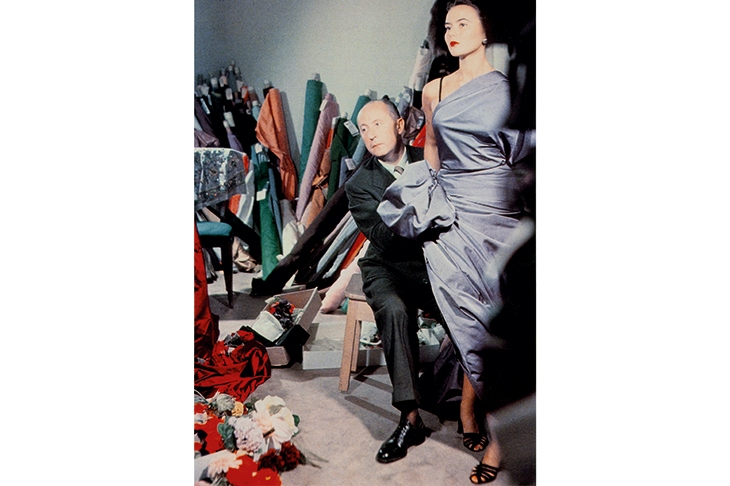Strange to think when you visit the Christian Dior show at the V&A that his time as designer was so very short. From the first show in 1947 when he brought the war to an end — at least in terms of clothes — with the New Look, to his sudden death at the age of 52 was just a decade. But in that brief time he brought about a revolution in fashion, creating some of the most beautiful dresses ever made for women, with a line that was wholly his own.
It was both architectural and natural: the skirt of his celebrated Bar suit was based on the corolla of a flower. He was a creative genius, but also brilliant at PR and commercially astute, as you would be if you’d lived through the interesting times he had. There are no fashion designers now with a fraction of his cultural hinterland, or his experience of life.
The first costume in the V&A exhibition is that celebrated New Look Bar suit with nipped-in waist and flowing skirt, but if you can tear yourself away, on the walls is an account of the man himself, with pictures of his childhood home in Normandy and of his ‘distant’ mother. He described her as the only member of his family of hearty eaters who was slim and with a small appetite; it doesn’t take much to surmise that it was she who gave him the ideal of slender elegance that characterised his work. The family fortune came ingloriously from bird droppings: his great-grandfather was one of the first to realise the commercial possibilities of guano fertiliser.
He was born in 1905: ‘I thank heaven I lived in Paris in the last years of the belle époque,’ he wrote. ‘My mind retains the picture of a time full of happiness, exuberance and peace in which everything was directed towards the art of living… the future, it seems, could only hold greater comfort for everybody.’ You could say that in his clothes there’s a yearning for that lost world.
There’s an interesting portrait of Dior as a young man by Paul Strecker with a sweet, introspective face. In fact, he was a youthful rebel bohemian: he wanted to study architecture but his parents insisted on political science. He ended up dropping out and studying music. ‘Naturally my family’s stable and comfortable position meant I became a professed anarchist as well as a pacifist,’ he observed. When he set up a picture gallery with a friend he focused on Braque, Picasso, Matisse and Dufy, on his parents’ condition that the name of Dior was kept out of the business. One of his greatest friends was Dali (who later inspired a collection and with whom Dior worked on the Beistegui ‘ball of the century’).
And then calamity. His mother died and the crash of 1929 hit France. The family, heavily invested in real estate, was ruined. Dior made for Soviet Russia with a group of architects where he lost any illusions about communism.
His route to fashion, on his return, was rackety. Penurious (in a stylish way), he sold some fashion sketches and got work with Robert Piguet as a dress designer even though he, like Chanel, ‘could hardly hold a pencil’. During the war, he spent two years in the army before returning to Paris to work with Lucien Lelong, who kept the French fashion industry going under occupation. Work was the way he coped with the deportation of his sister to Ravensbrück for her work with the Resistance: she was freed later and he named his scent Miss Dior after her.
But what he really hated about the war was its hideous effect on fashion: ‘Hats were far too large, skirts far too short, jackets far too long, shoes far too heavy,’ he observed. He got his revenge after it was over, when he found a financier, Marcel Boussac, in search of a designer.
Instructed by a fortune-teller to accept Broussac’s offer of funding for his own fashion house, Dior, with an astonishing sense of purpose, declared that he wanted something new: clothes ‘which would give an impression of simplicity, [but] would in fact involve elaborate workmanship.’ That first 1947 show took fashion by storm. His Bar suit was, in a way, a return to his thwarted career: ‘In order to satisfy my love of architvecture… I wanted my clothes to be constructed like buildings. Thus I moulded my dresses to the shape of the female body, so that they called attention to its shape.’ It signalled to women desperate for beauty and elegance that the war and austerity were over; it was, you might say, liberation for women. That was notwithstanding a backlash from the puritans: Stafford Cripps tried in vain to get journalists to object to the yards of cloth Dior lavished on skirts. And there’s a picture in the exhibition of a spirited demonstration in Chicago directed at Dior, with catchy slogans on placards: ‘Mr Dior/ we deplore/ skirts that go down to the floor’. Spoilsports.
After that first sensational show he never looked back. He was lionised abroad: there would be actual espionage to try to find out the shape of his new collections. A section of the V&A display is given over to Dior in Britain, where he was extraordinarily popular and a favourite of Princess Margaret, whom he adored. We get the very dress he designed for Margaret’s 21st birthday, immortalised by Cecil Beaton.
In his biography he talks about two Christian Diors, the couturier and the private man. Yet it’s impossible to understand the first except in terms of his past, not least his uncompromising craftsmanship.
Only the first three rooms of this show are given over to Dior himself; after that, it’s a show about the House of Dior, in which his pieces are mixed with those of his successors. It’s all beautiful, but the problem is that when any of them aren’t in his league, it shows. His designated heir, Yves Saint Laurent, was, and in a flamboyant and theatrical way the Brit John Galliano stands comparison, but unfortunately for the house, the present incumbent, Maria Grazia Chiuri, doesn’t really come close to the master.
But then, ours isn’t a stylish age: maybe elegance is incompatible with feminism. Dior would have been appalled at the drab utilitarianism that characterised the party that launched this exhibition; the fashion set isn’t what it was. And he took his calling as designer seriously: ‘His role,’ he wrote, ‘is to be guardian of the public taste.’
Nevertheless it’s a timely show — as my fashion friend Tamasin put it, the antidote to Brexit. Dior observed that: ‘When someone objects to the fact that my toilettes are ill suited to the serious times in which we live, I reply that a period of happiness is no doubt on the way when these frivolous fashions will come into their own.’ It’s hardly a period of happiness, but the escapist beauty of his clothes is exactly what we need right now.







Comments